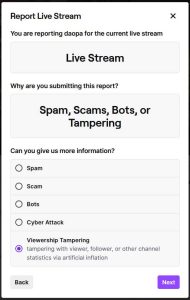Hey, Twitch fam—whether you’re a viewer, a newbie streamer, or a grizzled vet like me, you’ve probably noticed the platform’s latest move. They’ve added a “Viewership Tampering” option to the “Spam, Scams, Bots, or Tampering” report category, targeting anyone artificially juicing their viewer counts, followers, or other stats. The official line? “Tampering with viewer, follower, or other channel statistics via artificial inflation.”
As someone who’s been streaming through the late nights for over a decade, I’ve watched Twitch grow from a scrappy startup to a global stage. This update’s got my attention—not just for what it says, but for what it’s up against. Let’s dive into what “tampering” means, why it’s a beast to tackle, and how features like Drops and Shared Viewcount fit into this messy picture.
Breaking Down “Tampering”
The Viewer Count Illusion
Artificial viewer inflation—good old viewbotting—is when someone pumps up their live viewer numbers with automated scripts. It’s been around forever. You’ve seen it: a stream with hundreds to thousands watching instantly. These days, it’s sneakier—bots join slowly, faking organic growth. It’s a cheap trick to climb the directory or catch a casual viewer’s eye, but it’s all smoke and mirrors. No engagement, no community—just numbers on a screen.
Follower Fakery
Then there’s follower tampering. Remember that streamer who recived over 4.6 million followers overnight?

Stats on Steroids
“Other channel statistics” covers the rest: fake chat spam, inflated sub numbers, or juiced-up view histories. Picture bots flooding chat with “PogChamp” or “Great stream!” to mimic a buzzing community. Or scripts tweaking past view counts to look impressive. It’s not just vanity—these stats mess with Twitch’s algorithms, giving tampered streams an edge in visibility. That tilts the playing field, especially for the new clips features coming online at twitch.
Viewbotting: The Unkillable Monster
Viewbotting’s the core of this mess, and it’s a headache that won’t quit. Twitch has tech wizards on it—AI, pattern tracking, the works—but bot makers keep evolving. Unique IPs, staggered joins, random usernames—it’s like trying to nail jelly to a wall. Sometimes it’s not even the streamer pulling the strings; a troll can bot a channel to get them banned. It’s a tech arms race, and right now, no one’s got the upper hand.
How the Big Players Fight Back
Twitch isn’t the only one wrestling with this. YouTube’s been zapping fake views for ages—sometimes a video loses millions overnight when their system catches up. TikTok’s got AI sniffing out bot likes, and Instagram’s culled fake accounts with phone verification sweeps. Talk to creators there, and they’ll tell you it’s a dent, not a fix. The bot industry’s too quick, and the profits too sweet. Twitch’s new report button is a solid jab, but it’s not knocking out the problem.
Shared Viewcount: The Alt-Account Hustle
Here’s where it gets interesting. Twitch added this report option also from my opinion partly to tackle Shared Viewcount abuse. It’s a feature meant for collabs—streamers team up, pool their audiences, and boost exposure. I’ve seen channels pull it off brilliantly (check my take on it here). But some are gaming it with alts—dummy accounts they control to inflate the numbers. Viewers can now flag this, and honestly, it’s about time. It’s a blatant rule dodge and easier to catch than slick viewbots.
Twitch Drops: Fuel on the Fire
Twitch Drops are another twist in this saga. They’re a genius hook—watch streams, snag in-game loot—but they pull in viewers who don’t care about the content. These lurkers hang out, AFK, farming rewards, and pump up viewer counts without adding life to the stream. It’s a natural inflation that blurs the line between legit growth and fakery.
Many creators are now getting savvy, going 24/7 during game launches with Drop Campaigns to reap the rewards of non-engaged viewers. Take this example: a hack-and-slash game dropped a beta with a Twitch Drops campaign, tossing in a bonus—gift a sub to a streamer, get a pet reward. What happened next? A handful of big creators went full 24/7, exploiting it to the hilt. We’re talking AFK content, VOD reruns, videos of TV shows with the game in the background, sleeping cams, and other gimmicks during there off time, when they are usually not streaming. The highly sought-after drop rewards drew so many non-engaged viewers that it snowballed these channels to the top of the directory. It’s a loophole that thrives on apathy, not bots, but it still warps the platform’s balance.
Why This Matters
Twitch runs on trust. Fake stats scare off sponsors—who’s gonna pay for phantom eyeballs? Bots clog the directory, burying honest streams. Drops and shared viewed alts muddy the waters even more. This new report tool is Twitch tossing us a lifeline, saying, “Hey, help us spot the cheats.” It’s not perfect—false reports could pile up, and bots don’t flinch at a few flags—but it’s a start. The real strength lies in us, the community. Support creators you enjoy, engage with folks in chat, be the real deal. If more of us lift each other up with genuine vibes, the fake stuff can’t compete.
Where We’re Headed
This report option feels old-school—Twitch leaning on us to keep things clean, like the early days before the tech took over. I dig it, but it’s not enough solo. Pair it with smarter Drops policies and sharper bot detection, and we might tip the scales. For now, the tamperers will keep tampering—bots, alts, whatever works. But the more we focus on what’s real—great streams, real connections—the less room there is for the fakes to thrive. Let’s keep Twitch a place worth streaming on, one honest watch at a time.




